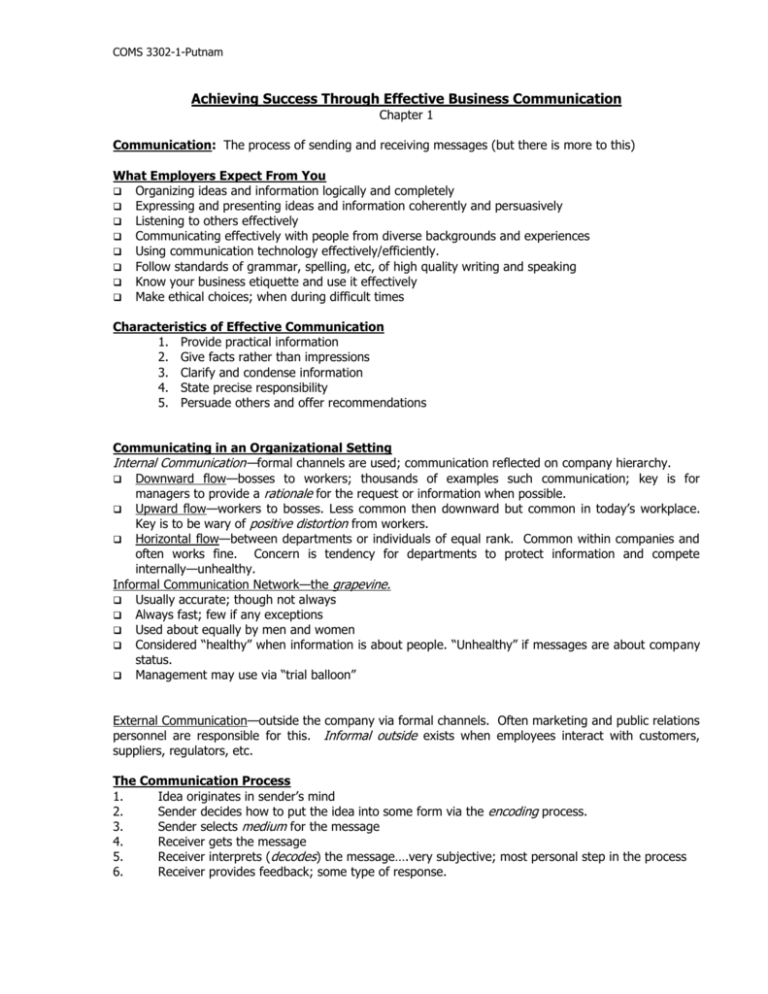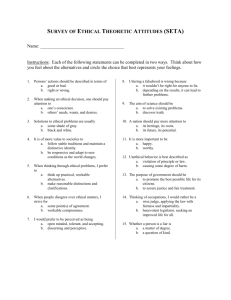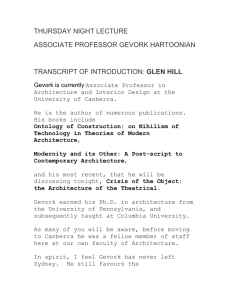Achieving Success Through Effective Business Communication
advertisement

COMS 3302-1-Putnam Achieving Success Through Effective Business Communication Chapter 1 Communication: The process of sending and receiving messages (but there is more to this) What Employers Expect From You Organizing ideas and information logically and completely Expressing and presenting ideas and information coherently and persuasively Listening to others effectively Communicating effectively with people from diverse backgrounds and experiences Using communication technology effectively/efficiently. Follow standards of grammar, spelling, etc, of high quality writing and speaking Know your business etiquette and use it effectively Make ethical choices; when during difficult times Characteristics of Effective Communication 1. Provide practical information 2. Give facts rather than impressions 3. Clarify and condense information 4. State precise responsibility 5. Persuade others and offer recommendations Communicating in an Organizational Setting Internal Communication—formal channels are used; communication reflected on company hierarchy. Downward flow—bosses to workers; thousands of examples such communication; key is for managers to provide a rationale for the request or information when possible. Upward flow—workers to bosses. Less common then downward but common in today’s workplace. Key is to be wary of positive distortion from workers. Horizontal flow—between departments or individuals of equal rank. Common within companies and often works fine. Concern is tendency for departments to protect information and compete internally—unhealthy. Informal Communication Network—the grapevine. Usually accurate; though not always Always fast; few if any exceptions Used about equally by men and women Considered “healthy” when information is about people. “Unhealthy” if messages are about company status. Management may use via “trial balloon” External Communication—outside the company via formal channels. Often marketing and public relations personnel are responsible for this. Informal outside exists when employees interact with customers, suppliers, regulators, etc. The Communication Process 1. Idea originates in sender’s mind 2. Sender decides how to put the idea into some form via the encoding process. 3. Sender selects medium for the message 4. Receiver gets the message 5. Receiver interprets (decodes) the message….very subjective; most personal step in the process 6. Receiver provides feedback; some type of response. COMS 3302-1-Putnam Understanding Why Business Communication is Unique Adapting to Challenges in the Workplace Globalization of Business and Workforce Diversity. Culturally diverse work force; challenges and goals The Increasing Value of Business Information—key areas are competitive insights, customer needs, and regulations and guidelines. Pervasiveness in Technology. The Internet and e-commerce realities/increased speed The Evolution of Organizational Structures—how much corporate hierarchy exists; levels of management; tall vs. flat structures and the advantages of each one. And the role of corporate culture and how it impacts communication. Team-based organizations; teamwork and collaborating with others; command-and-control element is leaving. Can be a real pain in the you-know-where, but it’s a real issue for companies. Communication Barriers (page 14) Differences in perception —We all try to make experiences fit our realities. The more we share common experiences with others; the easier this is. Restrictive Environments—authoritarian or rigid organizational environments reduce communication. Many employees often feel isolated and meaningless. Distractions—sometimes as basic as hard to hear; poor copy quality….to lack of effective listening by others… to strong emotional reactions…to information overload. Deceptive Tactics—managers or others who manipulate feelings of workers. Unethical, without question. Leaves workers feeling a lack of respect. How to Overcome Such Barriers? Be perceptive—anticipate how others are likely to react Precision—try to be exact and specific as to meaning Credibility—establish trust by actions and never change Control—be confident in yourself and behavior Congeniality—be nice to people; demonstrate respect Guidelines to Improve Communication in Companies 1. 2. 3. 4. 5. Adopt an Audience-Centered Approach—always remember why you are communicating; design your message for your audience; not for you. Theme of much of this course and text. Minimize distractions(noise)—this means both external as well as internal types. External can be easy to identify and reduce. Internal like day-dreaming and semantic issues can be much harder. Create an Open Communication Climate— The organization’s corporate culture (personality) is key here. The flatter organizational hierarchies are good; messages move faster and often creates good feelings. But can’t be too flat or messages snarl at the top. Chances for employee feedback usually help create the open climate. Creating lean, efficient messages— Too easy to flood employees with email, etc. Think before sending information; is it needed? Keep focus on your message; watch for distractions Use technology wisely; time and place for it. Give constructive feedback. Focus must be on the work not the person. You want to improve performance not create walls of defensiveness. This is a hard to do, but honesty is essential while doing so in a positive and constructive manner. Commitment to Ethical Communication-Ethics—relates to a value system of cultural beliefs; standards of conduct; what a society deems as being right or wrong. Something may be unethical but legal. COMS 3302-1-Putnam We all have personal ethical guidelines; concern here is for corporate ethics as well. Key terms: ethical communication, ethical dilemmas, and ethical lapses. It’s easy for individuals and companies to be ethical with times are good; but life doesn’t run like that all the time. Being “ethical” when business times are good is easy. When times get hard, high ethical principles become more challenging. We are often faced with “ethical dilemmas.” Ethical Codes of Conduct have become the norm now. (90%) Two Ethical Theories: 1. The Golden Rule—“do unto others….” This is the full, straightforward disclosure of the truth. Sounds great; not always easy to apply in reality. 2. The Social Utility Concept—carefully evaluate options and then choose the alternative that does the greatest good (or least harm). The good of everyone needs to be considered.



